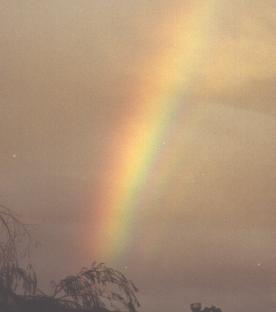SKYLIGHTS

Photo of the Week.. Strong "supernumerary bows,"
caused by the interference of light inside raindrops, lie beneath
the primary rainbow.
Astronomy news for the week starting Friday, February 8, 2002.
The early part of the week belongs to the waning crescent Moon, as
it heads toward its new phase, which will be reached on Tuesday,
the 12th. You will see the beginning waxing crescent, beautifully
illuminated by earthlight, the night of Wednesday the 13th in
western twilight. Enjoy the sight.
The planetary news belongs mostly to Saturn. Both it and Jupiter
now dominate the evening sky. Saturn, beautifully set just north
of the jewel-like Hyades in Taurus and to the south of the
even-prettier Pleiades,
crosses the meridian to the south around 7 PM, while much brighter
Jupiter (the brightest body in the night sky after the Moon), in
western Gemini, makes the same
passage around 9 PM. As the pair slip ever-farther into the
western sky, their retrograde, westerly, relative motion against
the background stars slows. On Friday the 8th, Saturn's comes to
a complete halt. From now on until we make our next passage
between the planet and the Sun,
Saturn will return to its normal easterly motion, and begin to move
away from its current partnership with the Hyades. Jupiter will
follow suit in three weeks.
Farther out from Saturn lie the two smaller and more mysterious
planets Uranus and Neptune. Both in Capricornus, Neptune (to the west of Uranus) passed
conjunction with (far to the other side of) the Sun a couple weeks
ago, and now it is Uranus's turn, the alignment taking place
Wednesday, the 13th. In the other direction, the asteroid Juno is
in opposition to the Sun. Though, with a 150-mile diameter ranking
thirteenth in size, it was the third asteroid to be found nearly
200 years ago, and among the largest 15 asteroids after Vesta (the
only asteroid visible to the naked eye) the second-most reflective.
The asteroids, countless numbers of them lying between the orbits
of Mars (still easily seen in the west in early evening) and
Jupiter, remind us of the power of giant Jupiter, whose gravity has
kept them so stirred up that instead of combining to form a planet,
their violent collisions just keep grinding them down.
The lack of bright moonlight now brings out the brilliant winter
stars. Orion crosses the
meridian about 8 PM, Canis Major
with Sirius following about an
hour later. If you have a particularly dark sky, you can see the
faint glow of the winter Milky Way sliding down from Taurus and
Auriga to the left of
mighty Orion and then past the Great Dog.
Our Sun is set rather well off to the edge of the disk that makes
our Galaxy and the Milky Way. At this season, in the evening we
face away from the center, and the Milky Way becomes soft and
subtle, less grand than the summer version, but in its way no
less beautiful.







